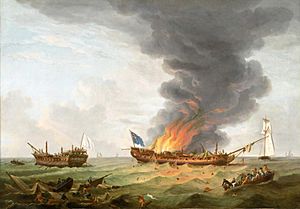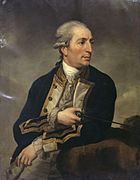Action of 6 October 1779 facts for kids
Quick facts for kids Action of 6 October 1779 |
|||||||
|---|---|---|---|---|---|---|---|
| Part of the American Revolutionary War | |||||||
 The Quebec and Surveillante in Action, 6 October 1779, by Robert Dodd |
|||||||
|
|||||||
| Belligerents | |||||||
| Commanders and leaders | |||||||
| Strength | |||||||
| 1 frigate 1 cutter |
1 frigate 1 cutter |
||||||
| Casualties and losses | |||||||
| 115 killed or wounded | 127 killed or wounded 1 frigate destroyed |
||||||
The Action of 6 October 1779 was a fierce and well-known naval battle. It happened early in the American Revolutionary War. This war was fought between Britain and France. The battle involved the British frigate HMS Quebec. It also included the French frigate Surveillante. The fight ended with a French victory. The Quebec was destroyed by a huge explosion.
Contents
Why This Battle Happened
France and Spain joined the American side in the American Revolutionary War. This meant war was declared between France and Britain. Britain did not try to block French ports closely. Instead, a group of fast ships called frigates watched the ports. Bigger warships, called ships of the line, stayed anchored in safe places.
One of these British frigates was HMS Quebec. It had 32 guns and was led by Captain George Farmer. While operating near Guernsey, the Quebec hit a hidden rock. To get free, they had to throw heavy cannons overboard. When the ship was repaired in Portsmouth, there were no replacement cannons. So, the Quebec went back to sea with smaller guns.
On October 6, the Quebec was working with a smaller ship. This was the British cutter HMS Rambler, which had ten guns. They spotted a French frigate and a cutter. By 8:00 AM, they realized these were the French frigate Surveillante. It was led by Captain Couëdic de Kergoaler. The other French ship was the cutter Expédition.
- Portraits of the commanders
-
A carving of Charles du Couëdic in the Musée national de la Marine at Brest
The Battle Begins
The Quebec got ready for battle. By 8:30 AM, the French frigate opened fire. The wind was light, making it hard to move fast. Within an hour, the Quebec was close enough to fire back. It was side-by-side with the Surveillante.
At first, the Quebec seemed to be winning. But the Surveillante matched every move. From 10 AM until 1 PM, both ships fired at each other fiercely. Soon, both ships and their crews suffered many injuries and damage.
Captain Farmer of the Quebec was wounded. His first officer was also badly hurt. He had to have his arm removed, but bravely returned to duty. Captain Couëdic of the Surveillante was wounded twice. His ship's masts and ropes slowly crashed down.
The Quebec saw a chance to win. But then, its own damaged masts also fell. The main and front masts fell away from the fight. However, the back mast fell onto the side where the guns were. This blocked many of the gunports with sails and ropes.
A Desperate Fight
The ships drifted closer together. The Surveillante's front spar got tangled in the Quebecs fallen mast. The Quebecs gunners kept firing through the mess. Captain Couëdic tried to board the Quebec to capture it. But his crew was pushed back with heavy losses. Couëdic himself received a third wound.
Both sides were in a difficult situation. Their main goal became fixing damage and helping the wounded. But then, a new problem started on the Quebec. A fire began on its tangled sails. This was caused by cannon fire. The fire quickly spread out of control. It even started to catch on the Surveillante.
Captain Couëdic managed to break free from the Quebec. He ordered his crew to chop off the wreckage that held the ships together. The fire on the French ship was put out. However, on the Quebec, the fire was very serious. It had spread inside the ship and could not be stopped.
Captain Farmer ordered the magazine (where gunpowder was stored) to be flooded. But it was too late. By 6 PM, the fire reached the magazine. British sailors jumped into the water, knowing what would happen. Farmer ordered the ship to be abandoned. Moments later, the Quebec exploded. Captain Farmer and many of his crew were lost. The Surveillante was far enough away to be safe. But it was too damaged to launch a rescue boat. Its crew could only throw ropes to sailors who swam close.
Meanwhile, the two cutters had been fighting their own battle. They were also badly damaged. When the Quebec exploded, rescuing survivors became the main task. The French cutter Expédition stopped fighting to help. The British cutter Rambler was too damaged to chase or help directly. It sent out a small boat instead.
After the Battle
Rescuing the sailors was hard. The sea was rough, and the wind was light. The Rambler's boat saved 17 British sailors. The Surveillante saved 39 British crew members. Another 13 were saved by a passing Russian ship.
The Surveillante was severely damaged. Its hull was leaking, and it had 30 dead and 85 wounded. British and French sailors worked together to keep the ship from sinking. They succeeded. The Surveillante returned to Brest the next day. It had to use temporary masts and sails.
Captain Couëdic and his French crew treated the surviving British sailors kindly. They were treated as shipwrecked people, not as prisoners of war. They were sent home without needing to be exchanged. Captain Couëdic died from his wounds in January 1780. He was admired by both the French and British for his bravery. The Surveillante took almost a year to repair. It later fought in American waters. It even brought news of the peace treaty in 1783.
Art About the Battle
Many paintings and drawings were made about this famous battle. Some notable artists include Auguste-Louis de Rossel de Cercy, George Carter, and Robert Dodd.
Images for kids
-
Painting of the battle by Francis Holman c. 1780
-
A lithograph based on a painting by Richard Paton c. 1780











